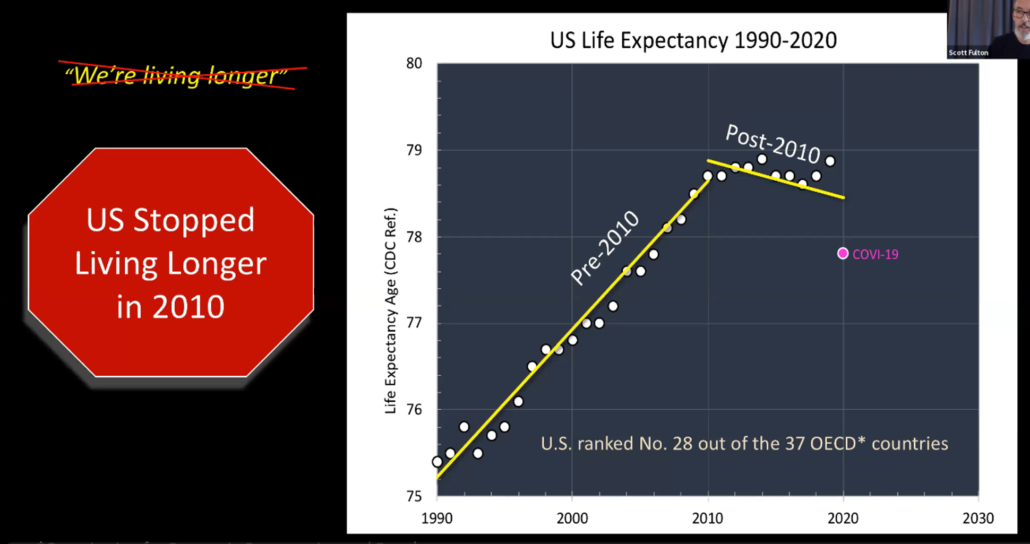Must life go downhill as we age, or do we have a choice?

Yes, life does go downhill, but –
-we have some choices in the matter.
Not with the eventuality of it, but with the starting point and the pace.
The reality is, we took out a death certificate at birth. Or, as retired Stanford geriatric physician, Dr. Walter Bortz once wrote:
“Life is a fatal disease. Once contracted, there is no known cure.”
Our brains will have matured by our early- to mid-twenties. We grow to physical and reproductive peaks in our late twenties. From that point, the gradual, eventual decline begins. Unnoticeable at first, but commencing insidiously and at a pace determined to a significant degree by-

-the lifestyle choices we make in these early years.
Contrast these two simple graphs:
Graph A:

Graph B:

Notwithstanding the rare chance that a person has blue-print errors (genetic defects) at birth, Graph A is, unfortunately, what the life curve becomes for most people across the average lifespan: a peak at mid-life followed by an accelerating downslope, often undetected at first and too often ignored when detected.
The start of this downslope and its severity is impacted significantly by the choices made earlier in life.
The pace and severity of the slope are also impacted by the choices made at mid-life and beyond.
Think of it as a golf game with a Front Nine and Back Nine.
(My thanks to Exercise Physiologist Dan Zeman for this analogy)

The choices made – for example, diet, exercise, stress relief – during the Front Nine lay the foundation for what the Back Nine may look like and what will need to be done to offset the poor choices in the Front Nine.
Continuing the analogy, one could say that age 40 (against the prevailing average lifespan of 80) represents the completion of the Front Nine.
If one starts the Back Nine overweight, sedentary, consuming the Standard American Diet (SAD), and living in a high-stress environment, the work that will need to be done to slow the acceleration of the aging process – that is, to recover – on the Back Nine, can be a challenge.
Professional golfers are knowledgeable enough about their game to sometimes be able to make corrections “at the turn” and recover from a disastrous front nine – perhaps a tweak to the grip, swing tempo, attitude adjustment, listening to their caddy, etc.
For those of us enmeshed in the typical western lifestyle, that type of Back Nine adjustment isn’t so easy because –
-we don’t know how our biology works!
Unlike a pro golfer, most of us enter the Back Nine naive to the “tweaks” that it will take to overcome the Front Nine mishits.
In our comfort, convenience, and comparison-driven western culture, we have little understanding or appreciation for what we do and don’t do to our biologies as we chase our dreams, climb our ladders, keep up with the Joneses.
The result is often a compounding of bad choices which we don’t fully understand to be bad choices until they start manifesting at or around middle age.
For instance-
-over 60% of the American male population is overweight, 25% are obese.

We weigh, on average, 15 pounds more than 20 years ago but we didn’t get any taller, just a lot rounder.
Lifestyle diseases – heart disease, cancer, stroke, diabetes, dementia – continue to increase as the major killers in western culture.
What changed about our biology that would cause that?
NOTHING. But our choices became less supportive of what our biologies need to function optimally over the long term.
We hit 40, 45, 50 and our biological life begins to morph, the degree of which depends on how we honored our birthright of good health in the preceding decades.
Here’s the reality.
In America, we are embarrassingly behind most other developed countries in the length of time that our elderly live in poor health and on our average life expectancy.

Lifestyle choices, before and after mid-life, play a big role in that statistic.
Is Graph B possible with a mid-life start?
Yes – or something closer to it than Graph A.
It’s never too late to start but always too early to quit.
Our bodies have amazing recuperative powers. Our collection of 35 trillion cells have been miraculously kludged together into an incredible immune system working 24/7 to fend off nefarious invaders and keep us healthy.
Yet, we ignore and abuse that system in our ignorance of what those simple cells need to do their job.
Once we understand what they need to function optimally and then act on that knowledge, we are on a track to salvage the Back Nine and Live Long and Die Short.
A short, personal story
I’m about to step into my ninth decade (for Kansas City Chief fans, that means I soon turn 80 years old).
Statistically, as an American male, I’m late for my funeral.
I grew up in the 1950s and can lay claim to a pretty crappy front nine. I smoked until age 37. My athletic/physical activities ceased after high school. My diet into my 50s was the SAD.
The lights began to come on June 6, 1979, when I quit smoking and began a slow progression into a lifestyle that remains today one of high levels of aerobic and anaerobic exercise, a departure from SAD and toward a more plant-based diet, and a commitment to avoiding traditional retirement.
I continue to work at what I’m good at and what I enjoy with the awareness that work is a key component of healthy longevity.
Graph B is my goal and my lifestyle choices are aimed at that with an endpoint that exceeds 100 years.
I have no illusions. My chances aren’t good.
I know it could be over tomorrow. My “right” choices started a little late to expect to get past 100. But, given the choice, I’m going for it rather than to accept the average, which I’ve already surpassed.
Avoid the accelerators.
In western culture, we face more “age accelerators” than ever in history. It’s evidenced by the fact that, after 120 years of meteoric improvement, our average lifespans in American have been declining for the last several years.

Source: Scott Fulton
Despite all the scientific and biomedical knowledge we’ve gained, we continue to choose to make bad lifestyle decisions in our pursuit of comfort and convenience and because we “compete to compare.”
We receive no help from a healthcare system that only knows cure and not prevention and a food industry that doesn’t give a rip about our health.
We’re on our own to make better choices based on knowledge.
Here’s an article that may help you make better choices and avoid the more common aging accelerators:
https://makeagingwork.com/2018/04/16/the-dirty-dozen-of-accelerated-aging/
Be “Younger Next Year” and make Graph B a reality.
Graph B comes from the life-changing book “Younger Next Year: Live Strong, Fit, and Sexy – Until You’re 80 and Beyond.” (paid link)
Make reading it one of your choices.
And adopt the appendix, entitled Harry’s Rules, written by co-author Dr. Henry Lodge:
Harry’s Rules
- Exercise six days a week for the rest of your life.
- Do serious aerobic exercise four days a week for the rest of your life.
- Do serious strength training, with weights, two days a week for the rest of your life.
- Spend less than you make.
- Quit eating crap!
- Care
- Connect and commit.
Seven clear choices to avoid the downhill.
D0 you have a plan to enact Graph B. We’d love to hear about it. Leave us a comment below.





Leave a Reply
Want to join the discussion?Feel free to contribute!